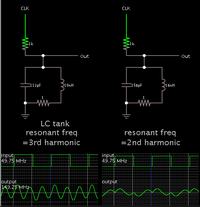BOHAA
Newbie level 3
crystal oscillator for application of 150 MHZ
Dear all,
I want to implement a crystal oscillator circuit to generate a signal of 150HHZ and the available XLAT I have is 49.86MHz Can anybody help me to find this kind of circuit ?
And through my search in internet I found this circuit. However, I am not quit sure if this circuit will generate the required frequency(150MHz).
Here is the circuit

Thank you alot
Regards
Dear all,
I want to implement a crystal oscillator circuit to generate a signal of 150HHZ and the available XLAT I have is 49.86MHz Can anybody help me to find this kind of circuit ?
And through my search in internet I found this circuit. However, I am not quit sure if this circuit will generate the required frequency(150MHz).
Here is the circuit

Thank you alot
Regards
Last edited:
